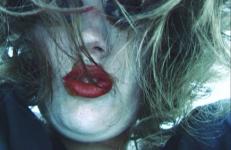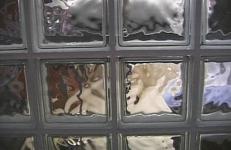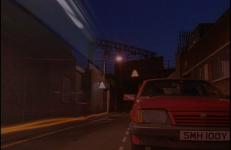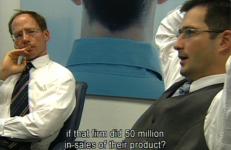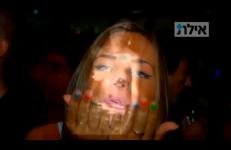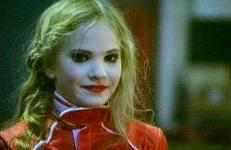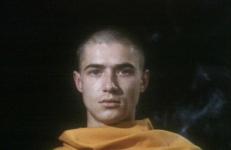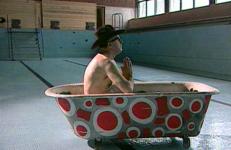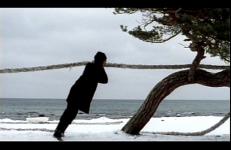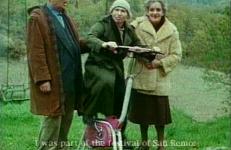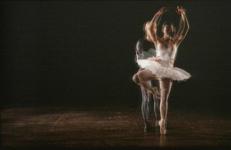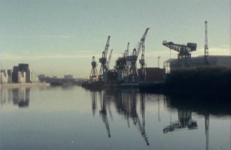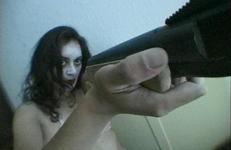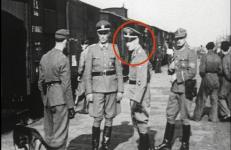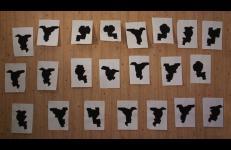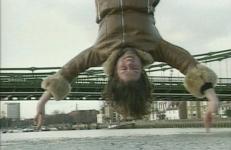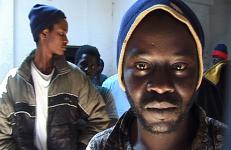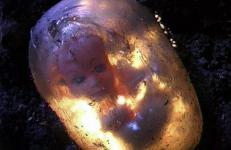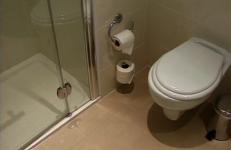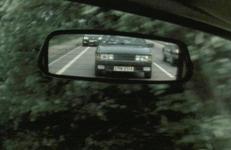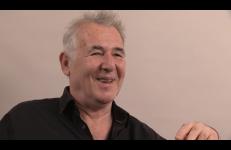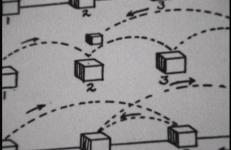"Mama mama mama...," a woman calls out again and again, over and over. Is it her child that she mimics, or is she calling for her own mother? A desperate video performance in the first person.
European Film/Video
A distinguished looking man (performance artist Richard Layzell) is apparently trapped in an ever changing void of colour, locked in a power play with a perversely operated camera. A mute, caged, charismatic TV presenter he is by turns charming, menacing, educational, confused. At times he appears to have great powers. A voiceover tells us extraordinary things — how this man is special — the first man to 'have a baby'. Hallucinogenic flash-frames punctuate the colour field to give us a view of his world's disturbing and alien futuristic logic.
Made in Germany, October 14th, 2004
While the Iraq war continues, a day's sightseeing and the features of a German hotel provoke a stream of thoughts about events large and small.
Museum Piece is the second episode in the Hotel Diaries series, a collection of video recordings made in the world's hotel rooms, which relate personal experiences and reflections to contemporary conflicts in the Middle East.
Nocturne is a 5-minute film shot entirely at night in deserted streets of London. The film attempts to find images of the city that reveal the presence of the past, or the presence of the dead, hinting at a concealed history. The deserted streets around the east end of London and Docklands reflect an echoic city filled with shadows. Nocturne is composed of long static viewpoints, each shot slowly unfolding in time as though by looking long enough the city's secrets will be revealed.
An examination of venture capital, Nothing Ventured documents the tough negotiations that take place when entrepreneurs and bankers meet.
O, Persecuted turns the act of restoring Kassem Hawal’s 1974 Palestinian Militant film Our Small Houses into a performance possible only through film. One that involves speed, bodies, and the movement of the past into a future that collides ideology with escapism.
A simple yet moving story of children and a baby deer set against the background of a go-kart track.
A film about haircuts, clothes, and image/sound relationships.
"This four-minute film explores our response to stereotypes—aural, visual and ideological. Smith signals these stereotypes to the viewer through a chiefly associational system, which deftly manipulates the path of our expectations. The structure is stunningly simple and deceptively subtle. We are taken on a journey from one concrete stereotype to its diametric opposite, as images transform and juxtapose to, ultimately, invert our interpretation of what we see and hear."
—Gary Davis
On the Flies of the Market Place deals with the idea of the European space, divided and sacrificed. In a visually surreal world of facts and emotions—using documents from books and magazines—the video suggests a re-reading of the European space, i.e. Eastern and Western Europe. Referencing history, philosophy (Kant), and art, the video elaborates on the idea of Eastern Europe as the indivisible residua of all European atrocities. Eastern Europe is a piece of shit and the bloody symptom of the political, cultural, and epistemological failures of the 20th century.
On the Flies of the Market Place deals with the idea of the European space, divided and sacrificed. In a visually surreal world of facts and emotions—using documents from books and magazines—the video suggests a re-reading of the European space, i.e. Eastern and Western Europe. Referencing history, philosophy (Kant), and art, the video elaborates on the idea of Eastern Europe as the indivisible residua of all European atrocities. Eastern Europe is a piece of shit and the bloody symptom of the political, cultural, and epistemological failures of the 20th century.
Outwardly from Earth's Center is a fictitious narrative about a society on an unstable piece of land that is in danger of disappearance. The situation requires the population's collective initiative in order to secure individual survival and to allow the society to remain. The concept's background is somewhat realistic since Sandön moves approximately one meter per year.
Panzano creates a matrix where the three most taken-for-granted elements of any film (camera, subjects, and the spaces they inhabit) are all delicately at odds with one another — allowed to float freely, gauge the terrain, and stake out a compromise. It could have all come across as hopelessly vague and amorphous were it not for the fact that this is ostensibly a home and presumably a family. The strange rituals, comings and goings, arguments and reconciliations, and — most crucially — perpetual limbo are, after all, merely our own.
— Carlos Garza
The orchestra begins and a male and female dancer move from opposite sides of the stage. The dancers embrace and begin the White Swan pas de deux from the ballet Swan Lake. However this is not the ballet as it is normally performed. The choreography has been re-staged so that in every single frame the two original dancers have been replaced by the bodies of four new dancers. The movement remains continuous, the characteristics of the dancers’ movements and gestures the same, but in each frame a different person occupies the dancers’ body spaces.
Petrolia takes its name from a redundant oil-drilling platform set in the Cromarty Firth, Scotland. The film looks at the architecture of the oil industry along the Scottish coastline where oil and gas supplies are predicted to run dry in the next forty years.
As if trapped inside a nightmare, the main protagonist of Poster Girl is haunted by disturbing visions, thoughts and fantasies, which the viewer is privy to. She is joined at various points in the video by another woman, whose role in the narrative remains unclear – is she meant to function as a guardian or a demon? The video further complicates the matter by representing both women as simultaneously wounded and wounding, inviting and threatening, vulnerable and menacing.
A portrait of the artist as a not-so-young man. The filmmaker attempts to enter the digital age by making a new video version of one of his old films.
"The award of the Short Film Festival goes to a video in which the reflection of artistic work becomes a form itself. John Smith manages to give us a self-ironic humorous experiment about art and time."
—Prize of the International Short Film Festival, Oberhausen 2000
This title is also available on John Smith: Program 2.
Respite consists of silent black-and-white films shot at Westerbork, a Dutch refugee camp established in 1939 for Jews fleeing Germany. In 1942, after the occupation of Holland, its function was reversed by the Nazis and it became a 'transit camp.' In 1944, the camp commander commissioned a film, shot by a photographer, Rudolph Breslauer.
Return of the Black Tower was conceived as a 'response' film to John Smith's 1987 classic short experimental film, The Black Tower.
"Barmy, baffling and weirdly funny,... an elliptical, satirical examination of contemporary belief, as much as it is about the problem of art as an incommensurate, incommunicable experience."
— JJ Charlesworth, Time Out London
Three people are taken for a short ride on the River Thames hanging upside down on the back of a speedboat. The journey is both a test of endurance and a simple way of forcing people to see differently. Upon reflection, the participants talk about their childhood and the places where they used to like to play and hang out. The very nature of the event leads the participants to remember and think about themselves and the ways they have changed.
Sahara Chronicle encompasses an undefined number of short videos documenting the present sub-Saharan exodus towards Europe. Taking a close look at the modalities and logistics of the migration system in the Sahara, the project examines the politics of mobility, visibility and containment which lie at the heart of current global geopolitics. The material is gathered during three field trips to major gates and nodes of the trans-Saharan network in Morocco, Mauritania and Niger where migratory intensity is bundled. No voice-over narrative strings these stories together.
This is the story of two young girls who dig up a tiny woman from the back garden. They incubate her in their mouths, in their bed, they lock her in a dolls house wallpapered with pornography to make her grow up faster, feeding her through a tube in the door. When she is life-sized and ready to play they take her to the disco. A dark, comic, experimental fantasy on the implications of Little Girls Toys — with the existential melancholy of Frankenstein's monster.
"A compelling exploration of a child's inner life and logic. Impressive and distinctive."
Ireland, October 20th 2007
The filmmaker returns to the city where he made the first video in the series and looks back at the events of the past six years.
Six Years Later is the eighth episode in the Hotel Diaries series, a collection of video recordings made in the world’s hotel rooms, which relate personal experiences and reflections to contemporary conflicts in the Middle East.
A nostalgic glazier shows off his knowledge and expounds his theories. Taking glassmaking processes and history as its central theme, Slow Glass explores ideas about memory, perception and change.
John Smith, throughout his 40-year career, has approached the moving image from film, video and installations, generating a tremendous body of work that’s as diverse in its topics as it is in its methods. Weaving between early structuralist film and more personal, diaristic, documentary approaches to the places in which he lived, most notably London, his output is both broad and varied.
Shot in Naples, Vienna, and New York, Some Chance Operations explores the notion of an archival form, in this instance film, as an unstable memory receptacle that can vanish. History and how it is made is meditated upon as one of many chance operations. The filmmaker Elvira Notari, who had a film production company in Naples from 1906 to 1930, plays a significant role as an impetus for Some Chance Operations. Despite the fact that she was a prolific filmmaker, producing over sixty feature films, only three remain intact.




